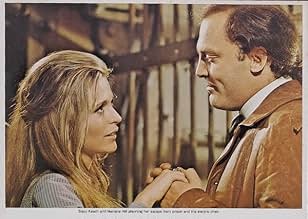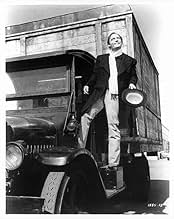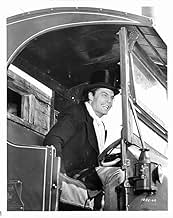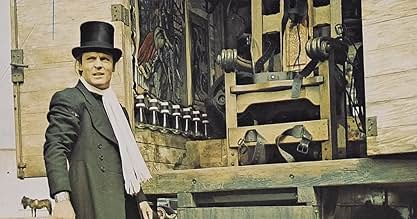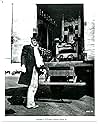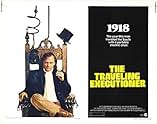Stacy Keach is electrifying as Jonas Candide, an ex-carny who in 1918 travels around the bayou with a portable electric chair. At $100 a head, he renders his services with loving care. But t... Read allStacy Keach is electrifying as Jonas Candide, an ex-carny who in 1918 travels around the bayou with a portable electric chair. At $100 a head, he renders his services with loving care. But then he falls for a female "client".Stacy Keach is electrifying as Jonas Candide, an ex-carny who in 1918 travels around the bayou with a portable electric chair. At $100 a head, he renders his services with loving care. But then he falls for a female "client".
Marianna Hill
- Gundred Herzallerliebst
- (as Mariana Hill)
James Sloyan
- Piquant
- (as James J. Sloyan)
Charles Tyner
- Virgil
- (as Bill Durham)
- Director
- Writer
- All cast & crew
- Production, box office & more at IMDbPro
6.3487
1
2
3
4
5
6
7
8
9
10
Featured reviews
Fields of Ambrosia
One of the great forgotten cinematic gems of yesteryear! From 1970, a young, whipcord fit, badass Stacy Keach stars as Jonas Candide, a traveling executioner who cruises the American South with his beloved portable electric chair, pulling the switch on murderers and thieves in 1918. Keach is shockingly good as he gets caught up in a scheme to save the life of a beautiful German woman slated for execution.
Keach's trademark facial scar is on full display here, not obscured by a mustache as it would be almost forevermore in later films. It adds something to the role, like a tiny crack in an otherwise perfect human statue. The film also features character actor Bud Cort in an early role.
The opening and finale scenes where Keach delivers Jonas' Fields of Ambrosia monologues are some of the best in 1970s cinema, and Jonas Candide is one of the great characters of Seventies film, he's a drunkard, a womanizer, a liar, a glutton, (the massive meal Candide sits down to eat after an execution has to be seen to be believed, massive plates of biscuits, Canadian bacon and Darwin knows what else) yet beneath it all he has a heart, Jonas, like the film, is darkly funny and darkly lovable.
Fantastically directed by Jack Smight, with a fine score by Jerry Goldsmith, and the seemingly only feature film screenplay credit by forgotten rebel screenwriter Garrie Bateson.
If there ever was a Traveling Time Traveler, a jump back into the wayback machine could correct the travesty of not nominating this film for Oscars for Best Actor, Best Director, Best Original Screenplay and Best Picture in 1970!
Keach's trademark facial scar is on full display here, not obscured by a mustache as it would be almost forevermore in later films. It adds something to the role, like a tiny crack in an otherwise perfect human statue. The film also features character actor Bud Cort in an early role.
The opening and finale scenes where Keach delivers Jonas' Fields of Ambrosia monologues are some of the best in 1970s cinema, and Jonas Candide is one of the great characters of Seventies film, he's a drunkard, a womanizer, a liar, a glutton, (the massive meal Candide sits down to eat after an execution has to be seen to be believed, massive plates of biscuits, Canadian bacon and Darwin knows what else) yet beneath it all he has a heart, Jonas, like the film, is darkly funny and darkly lovable.
Fantastically directed by Jack Smight, with a fine score by Jerry Goldsmith, and the seemingly only feature film screenplay credit by forgotten rebel screenwriter Garrie Bateson.
If there ever was a Traveling Time Traveler, a jump back into the wayback machine could correct the travesty of not nominating this film for Oscars for Best Actor, Best Director, Best Original Screenplay and Best Picture in 1970!
Great Entertaining Movie with Unusual Emotional Kick
I saw this film in Mexico around 1971 and I was so mesmerized by Stacy Keach's performance as a very eccentric traveling electrocutioner hired by Southern prisons to do the dirty deed. His hypnotic presentations to the condemned prisoners were heavenly and sublime as he always captured their attention by taking them to the "Fields of Ambrosia". I do remember thinking back then (1971) that these prisoners were being given a lot more than their warden ever bargained for. This was back in time when Soylent Green had come out and Edward G. Robinson was accepting the gift promised if he went along with assisted suicide. (This was set in the future when there was not enough food for the population and his remains would be used for processed food for people.) His quid pro quo was to watch pictures of all the extinct wildlife and other ecstatic beautiful scenes that no longer existed and nobody had had the privilege to ever see). Stacy Keach made the imminent execution so painless, that you would have thought the prisoners were wanting to die and experience the "Fields of Ambrosia". I am 70 years old and I do not go to many current movies any more as they are without art, taste, merit, etc, but I wonder why those who control the release of this movie won't let us old timers see it some more.
Underrated gem of 1970
This hard-to-find cool little film starring Stacy Keach is really special. A great performance by Keach (along with other early films of his, such as The Heart is a Lonely Hunter, Fat City, Judge Roy Bean, Brewster McCloud, and The Dion Brothers) and a fascinating study of this quirky traveling man who pushed his luck. Why is this not on video or DVD?
Before Keach became a Hollywood hack (with the exception of Long Riders) he made a series of films that showed the tremendous promise he had on stage. After the TV show Caribe he seemed to slide into obscurity except for Mike Hammer. This is a charming film that slipped under the radar in 1970 and is well worth your time. An 8 out of 10.
Before Keach became a Hollywood hack (with the exception of Long Riders) he made a series of films that showed the tremendous promise he had on stage. After the TV show Caribe he seemed to slide into obscurity except for Mike Hammer. This is a charming film that slipped under the radar in 1970 and is well worth your time. An 8 out of 10.
This here thing purely is an oddity.
This here thing purely is an oddity.
This is most definitely a Stacy Keach movie and most definitely a 'southern period wacky black comedy' product of 1970.
Despite the absurdity of the plot, the writers keep it on point.
Might be a good companion piece to "The Ninth Configuration" 1980.
If for no other reason than a young M. Emmet Walsh at work.
Shows the humanity that can be brought to any profession
This movie made a huge impact when I saw it in the theater. I was a tough (or so I thought) eighteen year old young man here in Vancouver when I saw it in 1970. I think that it might have played for a week.
I loved the humanity and charm that Stacy Keach brought to the executioner's role. I remember the loving way that he would sooth the fears of the condemned as they faced the terrors to come. It was a job that had to be done, and if he was the one to do it, he demanded craftsmanship and style.
The ending caught a deep nerve and I cried as I left and walked home. (It remains the only film that I can say that about). It is amazing how a film that is almost unknown has remained so brilliant in my mind.
I suspect that I might give it a higher rating if I ever saw it again.
I loved the humanity and charm that Stacy Keach brought to the executioner's role. I remember the loving way that he would sooth the fears of the condemned as they faced the terrors to come. It was a job that had to be done, and if he was the one to do it, he demanded craftsmanship and style.
The ending caught a deep nerve and I cried as I left and walked home. (It remains the only film that I can say that about). It is amazing how a film that is almost unknown has remained so brilliant in my mind.
I suspect that I might give it a higher rating if I ever saw it again.
Did you know
- TriviaThis was filmed at Alabama's then recently closed Kilby Prison off of Coliseum Blvd. in Montgomery. As part of an agreement with the state for filming rights, filmmakers were supposed to have demolished the prison's massive walls with pyrotechnics during/after the film. However, the walls were so thick, three charges failed to do the job, and their remnants stayed around for years afterwards.
- GoofsAn important plot point is the existence of a portable electric chair which makes the career of "traveling executioner" possible. Unfortunately, as shown in the movie, it can't work. To perform an execution Keach "starts" a big electric generator in his horse-drawn van. But the generator has no power source! At the time the story takes place the internal combustion engine was new and rudimentary. The only transportable source of mechanical power was the steam engine. There were no diesel powered generators. Of course a steam engine large enough to produce the necessary mechanical power to turn the electric generator would have been almost as large as the van and would have required hours to build up enough steam to do the job. Also, a substantial amount of coal to make the steam would be needed. In any case, no motive power is shown and this explains why there were likely no traveling electrocutionists. Why a remote prison would not simply hang convicted criminals is likewise not explained.
- Quotes
Jonas Candide: [seduced by Gundred] Her ass is too good to fry!
- ConnectionsEdited into The Lost Empire (1984)
- How long is The Traveling Executioner?Powered by Alexa
Details
- Runtime
- 1h 35m(95 min)
- Sound mix
- Aspect ratio
- 2.35 : 1
Contribute to this page
Suggest an edit or add missing content


